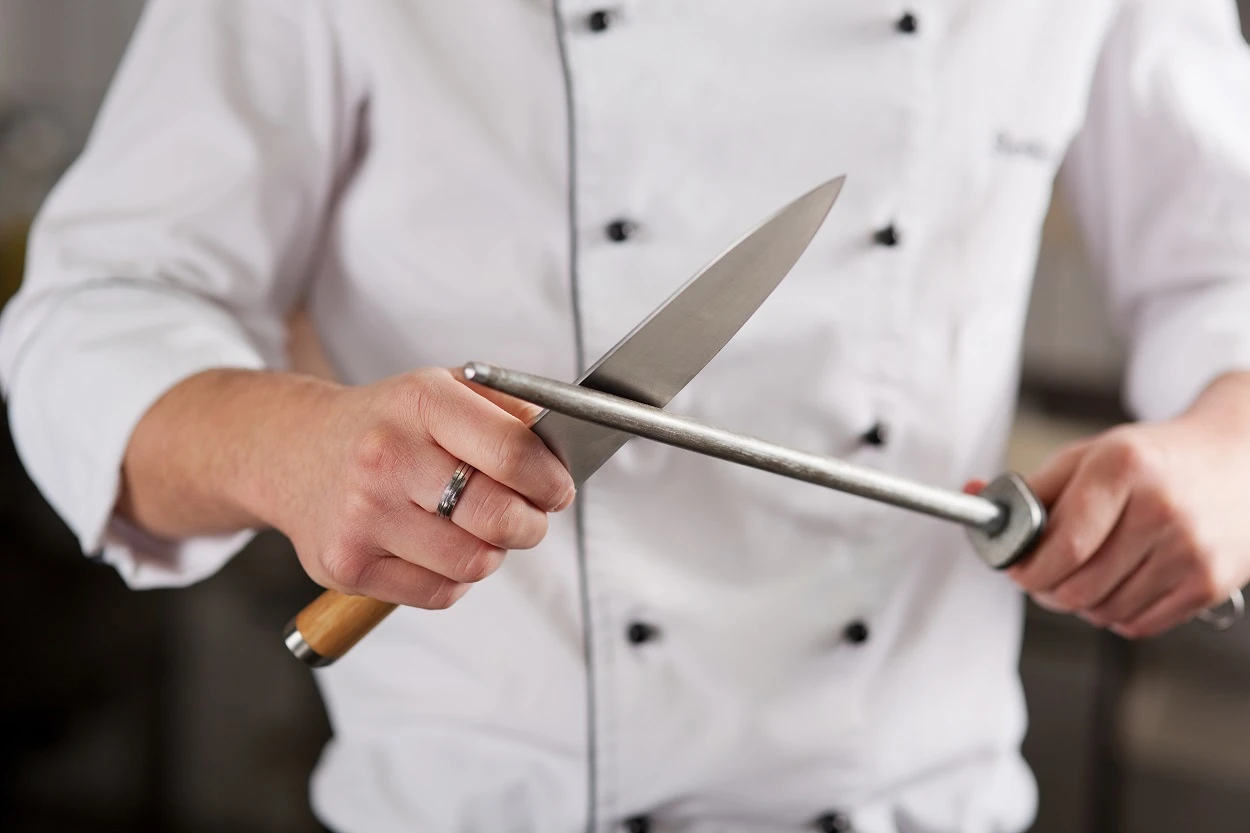Last Updated on 17th December 2021 by
It is very important to have an incredibly sharp knife to work with in the kitchen. Well sharpened knives are more effective and easier to work with than dull ones. They are also safer to use, since sharp knives make your cuts slip less.
If your knife is dull, it might slip as you try to cut tomatoes, carrots, and other dense foods. That slip can end with you cutting yourself or damaging your countertop, and you don’t want that at all.
So, keeping the knife sharp prevents accidents and makes for a safer kitchen experience. The sharp knife also cuts more quickly and will frustrate you less. Imagine trying to cut away at a tough piece of beef with a dull kitchen knife.
You will have to saw and saw at it and chop away again and again to make any progress. You will tire yourself out when you could be done in a fraction of the time by using a sharp knife instead.
I always try to use a very sharp knife when I work in the kitchen and to make sure that all of my kitchen knives are very sharp, checking them every so often to ensure they have a finely honed blade.
A dull knife is of little use, and you might as well be using a spoon for all the good it will do you. A lot of people don’t even have a kitchen knife sharpener, and then even more people don’t know how to use a knife sharpener.
There are a few different kinds of knife sharpening tools that you can use in the kitchen, and I will walk you through how to use a handheld knife sharpener and other tools to keep your blade effective and safe.
How to Use a Knife Sharpener Rod
One of the most common types of knife sharpeners used in kitchen is the sharpening rod. This lengthy tool is held in one hand at an angle and then you run the side of the blade of your knife across the rough end of the sharpener.
You want to be sure you hold the blade safely when you sharpen it, so that you don’t cut yourself. Most handheld sharpening tools like the rod or sharpening steel will work on similar principles. If you are wondering how to use a pocket knife sharpener, like a sharpening stone, then the method is quite similar.
You need to hold the sharpening tool so it is almost straight up and down. It can often be rested on a countertop while you hold one end, if you want more stability.
Then, you take your blade in the other hand (usually your dominant hand) and hold it at a 15 degree angle facing away from the rod or stone. Place the blade’s heel pressed against the sharpening stone’s edge.
The sharpening rod has no edge, but essentially holding the blade perpendicular angle while pressed against the rod will do the trick.
How to use a Lanky knife sharpener to sharpen your kitchen knife or pocket knife? Just maintain the 15 degree angle and slide the blade downwards across the stone or rod in a sweeping motion. You can pull the knife toward you as you work, and ensure that you keep the middle of the blade touching the middle of the steel.
How to use a knife sharpener tool to ensure the entire blade is sharpened and honed? You sharpen all the way down the length of the blade, using the same motion and angle as before. Work your way down to the tip and then turn the knife around to sharpen the other side of the blade.
Sharpen Effectively without Wearing Down
How to use a Lansky pocket knife sharpener in a way that doesn’t sharpen too much or wear down the blade too much? You could easily over sharpen the blade and make it too thin. You can wear away the blade out where it becomes overly thin and brittle.
That is definitely a problem you will have with sharpening, and you want to watch for that.
How to use a kitchen knife sharpener so that you are not sharpening too much? Just pass the blade about four or five times on each side, giving you a total of 8-10 passes or strokes. That should be enough to sharpen the blade effectively.
Sharpening stones and kitchen sharpeners are very effective at sharpening knives, so it doesn’t take a lot to get your blade to come out looking and feeling sharp once more.
How to Use a Smith’s Knife Sharpener
There is another knife sharpening tool that you can use, and a few different brands make these that are not handheld sharpeners at all. Instead, they are larger and heavier and rest on your countertop. They have a few slots for you to pass your blade through to sharpening it, so there is nothing for you to hold erect as you sharpen the blade.
I prefer this kind of sharpener. I think it is easier to use and so much easier to sharpen your knife effectively with. I talked about how to use a knife sharpener stone or rod, and now I want to cover how to use a Smith knife sharpener or countertop sharpener. It doesn’t sharpen your countertop, mind you, but instead rests on your countertop as you sharpen your knife.
This is also known as the V-shaped sharpener, and I will show you how to use a V-shaped knife sharpener. It’s even easier to use than the rod sharpener, but there is a similar sharpening concept at work. You simply run the knife through the slots on the sharpener, pressing down to apply some pressure.
You don’t hold it at an angle for this sharpening technique, since the slots are straight slots and there is no room to hold the knife at an angle. Make sure the entire edge passes through the slots, and you will likely need to pass the tip through on its own.
Just give each part of the blade’s edge a couple of passes through the slots, and it should be perfectly sharpened.
The ceramic knife sharpener is simply the same thing, so if you are wondering how to use a ceramic knife sharpener, you can follow this same guide.
How to Use a Rada Knife Sharpener
The Rada knife sharpener is a bit different than the other ones I have talked about so far, and it looks like a flat cloth with a couple of wheels on one end. Just lay the sharpening mat flat on a hard surface like a countertop and run the knife blade through the wheels.
Make sure the entire blade is passed through there and all of the edge is touching the intersection between the two wheels. That’s where the sharpening happens. You will need to press down as you sharpen to create some friction and force, and you will probably need to sharpen the tip separately, ensuring it gets sharpened specifically, since it is hard to sharpen the tip in the same pass as the rest of the blade.
Once again, a few passes are all that your knife needs in order to sharpen using this method.
Now you know how to use a work sharp knife sharpener or kitchen sharpener, and if you don’t have a sharpening tool, you should buy one for your kitchen. This useful implement may not be used often, but it helps to keep your knife very sharp and effective so you never have to suffer the frustration of using a dull kitchen knife.
I'm Pauline, a mother of four grown children, my passion for cooking stemmed from the joy i get cooking for my family. I love to try new dishes, especially when dining out but creating and sharing my own recipes is my favourite thing to do!



velit
Friday 21st of February 2025
FPF6eIjwm9L
Latoya Jordan
Wednesday 31st of March 2021
Hold the knife at a 20-degree angle against the whetstone, and gently drag each side of the knife against it a few times. Most whetstones have both a "coarse-grind side" and a "fine-grind side"—start with the coarse side if your knife is especially dull, then repeat the process on the fine-grind side.